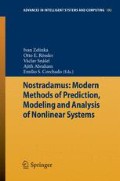Abstract
In a recent numerical experiment, the previously conjectured new fundamental physical discipline of cryodynamics, sister discipline to thermodynamics, was tentatively confirmed. Cryodynamics governs the statistical hyperchaotic behavior of attractively interacting particles. A terrestrial example is a hot plasma. The predicted phenomenon of paradoxical cooling (hotter particles cool the cooler ones in a process of anti-equipartition) can be used in principle to locally cool, and thereby stabilize, a thermonuclear fusion reactor of the ITER type.
Access this chapter
Tax calculation will be finalised at checkout
Purchases are for personal use only
Preview
Unable to display preview. Download preview PDF.
References
Rössler, O.E.: Hun Tun versus Big Bang: How classical chaos implies both thermodynamics and cryodynamics. International Journal of Bifurcation and Chaos 22(2), 1230007-1-1230007-9 (2012), Abstract: http://www.worldscientific.com/doi/abs/10.1142/S0218127412300078
Chandrasekhar, S.: Dynamical friction I, General considerations: the coefficient of dynamical friction. Astrophys. J. 97, 255–263 (1943), http://repository.ias.ac.in/21144/1/326.pdf
Rössler, O.E., Frohlich, D., Kleiner, N.: A Time-symmetric Hubble-like law: Light rays grazing randomly moving galaxies show distance-proportional redshift. Z. Naturforsch. 58a, 807–809 (2003), http://www.znaturforsch.com/aa/v58a/s58a0807.pdf
Zwicky, F.: On the red shift of spectral lines through interstellar space. Proceedings of the National Academy of Sciences 15, 773–779 (1929), http://www.pnas.org/content/15/10/773
Zwicky, F.: On the Possibilities of a gravitational drag of light. Phys. Rev. 34, 1623–1624 (1929), http://authors.library.caltech.edu/5559/1/ZWIpr29.pdf
Sonnleitner, K.: StV4: Ein symplektisches zeitreversibles Störmer–Verlet-Verfahren vierter Ordnung für Hamiltonsche Mehrteilchensysteme mit zwei Anwendungsbeispielen (Gas, T-Rohr-Anordnung)-. Ph.D. dissertation (2010), http://www.wissensnavigator.com/documents/StV4-universell.pdf
Author information
Authors and Affiliations
Corresponding author
Editor information
Editors and Affiliations
Rights and permissions
Copyright information
© 2013 Springer-Verlag Berlin Heidelberg
About this paper
Cite this paper
Rössler, O.E., Sanayei, A., Zelinka, I. (2013). Is Hot Fusion Made Feasible by the Discovery of Cryodynamics?. In: Zelinka, I., Rössler, O., Snášel, V., Abraham, A., Corchado, E. (eds) Nostradamus: Modern Methods of Prediction, Modeling and Analysis of Nonlinear Systems. Advances in Intelligent Systems and Computing, vol 192. Springer, Berlin, Heidelberg. https://doi.org/10.1007/978-3-642-33227-2_1
Download citation
DOI: https://doi.org/10.1007/978-3-642-33227-2_1
Publisher Name: Springer, Berlin, Heidelberg
Print ISBN: 978-3-642-33226-5
Online ISBN: 978-3-642-33227-2
eBook Packages: EngineeringEngineering (R0)

